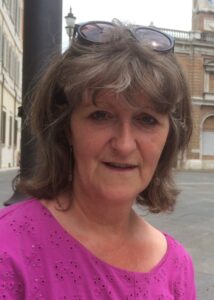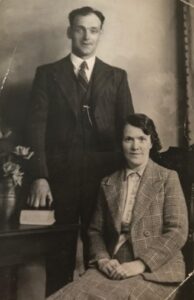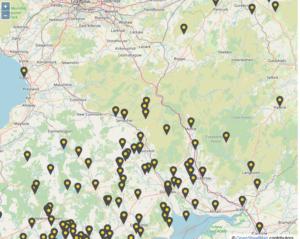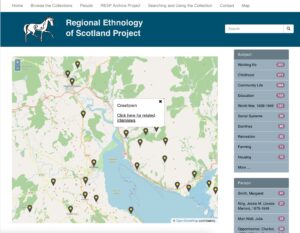We are always encouraging people to get involved with our Project, whether as a volunteer fieldworker or transcriber, or as a willing interviewee. As well as valuing the oral history interview for its own sake we are also keen to encourage and facilitate opportunities for people to get together and learn from each other about the community they live in. In this month’s blog post we hear from one of our East Lothian volunteer fieldworkers, Janis Macdonald, about her interest in social history, how she came to be involved with the RESP and what she has learned from her participation. To date, Janis has carried out 17 interviews with 18 interviewees and, as the following report demonstrates, she doesn’t seem to be thinking of hanging up her microphone anytime soon! We’re very glad to hear this!
 fieldworker, Janis Macdonald
fieldworker, Janis Macdonald
For as long as I can remember I have had an interest in family history. I was very close to my maternal grandparents and I used to love encouraging them to share stories of when they were younger. Both were local and came from large families. However, it wasn’t until more recently that I realised how little I actually knew about their early years. My nana used to deliver Sunday papers for her father, regularly cycling miles out into the country from Haddington. My papa went to school in Prestonpans. I also knew that, as the oldest child he took on responsibilities for the well-being of his siblings.
 my grandparents, William and Helen Cunningham
my grandparents, William and Helen Cunningham
On reflection now, I realise that most of the memories shared with me were from their married years, and the childhood years of my mother and her four brothers. My grandfather worked for the local Council and my grandmother for a local baker. I know they both had bikes and that my grandfather, having driven a Council lorry for many years, found the size of his first car challenging and it was regularly to be found parked quite far from the kerb! It’s often too late when we realise how little we know about our families.
Tracing family trees can give us names, dates and places but it is the social history that catches my interest. The Ethnology research project is helping us ensure that we can build our knowledge. People share their stories and this contributes to the pictures we have of when our relatives were younger.
I became involved in the Regional Ethnology of Scotland Project after attending a Haddington Remembered session with my uncle. At that event Ruth, one of the John Gray Centre archivists, asked if I would be interested in helping with fieldwork and later Mark, one of the project researchers, contacted me. He arranged a short training meeting for myself and two other interested volunteers. The session covered how to use the recording equipment, guidance on conducting interviews and there was also time to make some practice interviews. Now that I’m a fully-fledged fieldworker, I find I prefer to refer to the interviews as conversations. The term interview can seem a bit intimidating! Mostly I have engaged in guided conversations though, as I like to have a little knowledge of the person I am talking with!
My first conversation was with my mother-in-law and her twin sister. I felt a bit anxious beforehand but as they started talking I relaxed and it was good fun. One lesson I learned was that when the recorder was switched off the stories kept on coming! Mark gave me feedback on this first interview and commented on the electrical noise throughout the recording. It was my mother-in-law’s air mattress – a noise that we had become so used to that we didn’t give it a thought! Mark’s feedback was supportive and reassuring and he uses his experience to comment on recording levels, types of question and where there might be opportunities to elicit more information.
Everyone has a story to tell. I have had the privilege of talking with a number of local people who have grown up in East Lothian. Some may have similar experiences but each story has personal reminiscences which bring our County to life. East Lothian used to be called Haddingtonshire. The name Haddingtonshire conjures up a different way of life from East Lothian and, to my mind, lends itself to a more rural description. Rural links come across quite strongly in many of the conversations I have had.
It is also a real privilege to talk with people about East Lothian. It can be humbling to hear of their early years and make comparisons with those of today’s children. Despite what may appear to us now as hardships, their memories are usually positive and the importance of family and community comes through very strongly. I have been fortunate to know mostly all the people I have talked with, and my family has known their families. This connection has made these conversations all the more interesting to me. I can put faces to some of the personalities they mention, or even add to the reminiscences. Older people who knew my mother, and even those who knew my grandparents have told stories that I can make links to. Having lived in Haddington all my life, I too can remember the High Street shops as they were in the past: visiting several stores to acquire everything on the list – no credit cards, no scouring shelves for specific brands, no home deliveries and everyone had their own shopping bag!
As a volunteer fieldworker with the RESP I have been encouraged to follow my own connections and ideas while allowing each person the opportunity to speak about what matters to them. The people I have recorded have come from a wide range of backgrounds and our conversations have been varied – ranging from the drummer of a popular local band to a retained fireman working in Haddington. Stories I have heard cover a wide range of subjects too and have included changes in local businesses, school experiences, memories of World War 2, fashion, fishing life and Haddington Pipe Band. Although I have chatted with many older people, including a gentleman who is 101, I am also keen to record some school pupils in order to have contrasting experiences. And so there’s plenty to get on with and lots of people willing to share stories. Today’s events are tomorrow’s memories!
Janis Macdonald
You can find out more about the recordings made by janis on our RESP Archive website: www.collections.ed.ac.uk/eerc



